The late ripening Sercial grape is unquestionably the driest (up to 1.5% RS) and often the most crisp style of Madeira, with lemon, grapefruit and nutty nuances along with mineral characteristics. Madeira’s Sercial grape is noted for its rarity, as well as its fresh, razor-sharp -- some would say, “searing” – acidity, hints of VA and delicate mouthfeel as it ages.

Article by Roy Hersh © December 2016
Coming up with a name, no less a theme for our 5th annual Madeira event on April 30th 2016, seemed more difficult than in years past. Part of that stems from the fact that choosing to taste twenty consecutive glasses of Sercial, is not everyone’s idea of a “fun” afternoon. This grape can convey a more austere, if not sharply-edged acidic character. As a self-proclaimed, “acid freak,” the more the better for me, when it comes to Madeira, but I do realize I am likely in the minority here.
After last year’s event, a discussion ensued between co-hosts, focusing on whether or not a stand-alone tasting featuring the Sercial grape would appeal to enough of our guests. As I prefer the three grapes on the dry side of Madeira’s spectrum, (Sercial, Verdelho and especially Terrantez) it was not news to me that some guests would likely be diametrically opposed, considering their sweet spot. As our tasting events have already covered the sweeter styles represented by the Bual and Malvasia grapes, it was time to try something completely different.
Moreover, as we have been exploring all of Madeira’s noble grapes in this half-decade long series of Madeira events at Del Posto Restaurant in NYC, I felt strongly that Sercial should have its day in the spotlight. Fearing that we would never amass enough great bottles of old Sercial, Mannie Berk and I came to consensus on a broader-based theme incorporating the Sercial – Bastardo – Moscatel grapes into one tasting.
We then went to the well, asking our loyal participant friends to provide a list of bottles that they were willing to share from their cellars, for each of these three types of Madeira. Our expectations were vastly exceeded, and it became apparent that we had underestimated the extraordinary quantity of excellent pre-Phylloxera bottles of Sercial still available, as well as the other two cultivars.
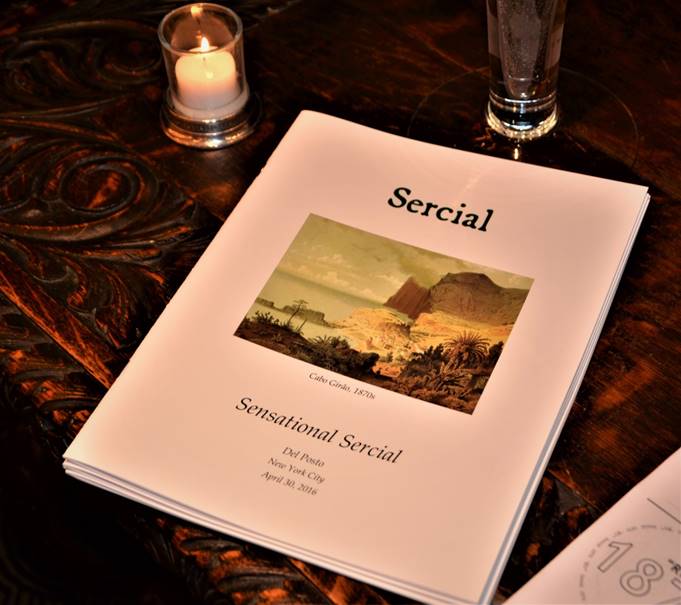
It was at that moment that we reversed course and decided that Sercial was going to make for a compelling and educational stand-alone theme, while putting off both Bastardo and Moscatel for next year’s gathering.
The weekend before this brief was written; I hosted a mixed group of Madeira neophytes and aficionados alike, who joined us from all across North America for a two day Madeira event in Seattle. My biggest surprise was how much people really enjoyed our Sercial flight. Granted that flight contained Sercial from the first third of the 20th century, and they were rounder and certainly sweeter than most of the ancient bottlings we had planned for the NY event. Nonetheless, it was impressive to see how widely the Sercial’s style and flavor profile was appreciated.
We typically decide to include a particular bottle due to its historic nature or extreme scarcity, rather than one that is still easy to come by. Lots of factors go into the final selection process of the actual lineup for game day. Our group varies only slightly from year to year, as we have included some of the greatest collectors and most serious aficionados of Madeira on the planet, including a few journalists and a winemaker or two from the island. Ricardo Freitas, major domo and winemaker extraordinaire at Vinhos Barbeito, is our renowned Guest of Honor.
Event planning with a friend from the opposite coast of the country, and utilizing a venue that is in an entirely different state, is no easy feat. As an example, just consider one intricate detail, of many dozens like it: arranging the delivery and eventual pick-up of 400 glasses from a rental company that no longer carries the glassware you’ve used in the past. I have been most fortunate to work closely with Mannie Berk, renowned owner of The Rare Wine Company, on this our 8th Madeira collaboration since 2007.
Our paths first crossed at a Madeira tasting in Florida, organized by a mutual friend who now is a guest at our annual Manhattan Madeirathon. Working with Mannie is a distinct pleasure. Not only because his depth of knowledge of Madeira is the most extensive in the world today; but his calm, flexible demeanor and remarkable skill set as an accomplished event organizing pro makes it worth all the months required to build and execute a seamless game plan, for our not-for-profit event.
Due to the striking generosity of our guests, this year’s comprehensive selection of twenty bottles of Sercial ranged from 1875 back in time to 1800, with a handful of bottles exceeding two centuries of age. We were all privileged to be able to participate in such a rare and historic Madeira tasting such as this.
After the event we had a rather lively discussion about the recent increase in fake bottles of Madeira turning up at auction in the past couple of years and how it seems to be a growing trend now that old bottles of Madeira are increasing in value exponentially. It seems some of the auction houses are not able to detect fakes with Madeira as easily as they can do with other types of wines. Whether it is due to a lack of knowledge of what to look for remained a contentious point.
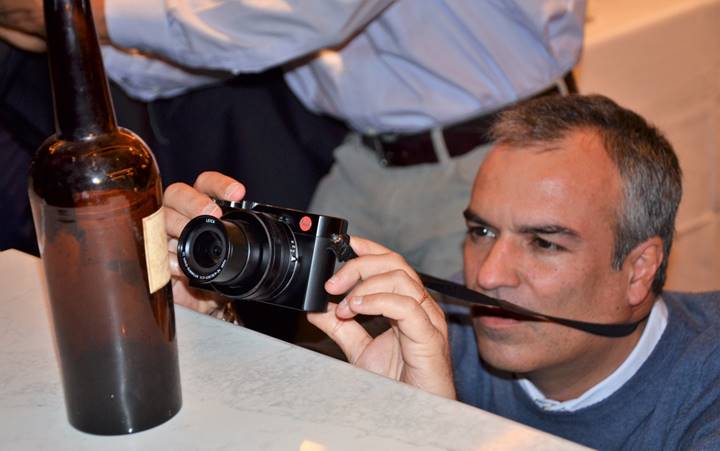
Ricardo Freitas, winemaker, photographer and Guest of Honor; from Vinhos Barbeito
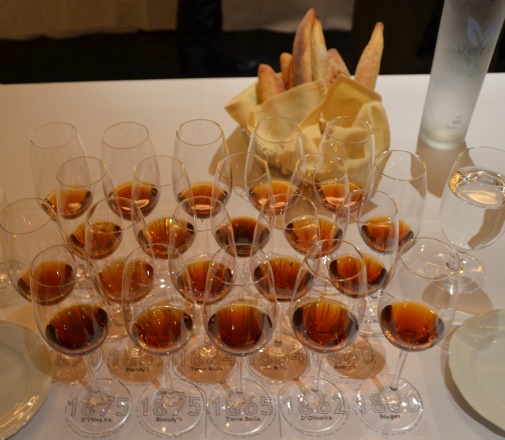
Please note: There is a detailed historical perspective of each wine by Mannie Berk (MB), which will precede my tasting notes included below (RH).
1st Flight:
MB: 1875 D'Oliveira Sercial
A 1960s -’70s bottling. The original company, João Pereira D’Oliveira & Filhos, was founded in the 1880s by a São Martinho landowner, João Pereira D'Oliveira. The business expanded in the early 1930s when D'Oliveira’s grandson, Agostinho, married into the Camacho family, adding the resources of the João Joaquim Camacho & Sons wine exporting firm. Some decades before, the Camachos had taken over an important nineteenth century producer, Julio Augusto Cunha & Sons, founded in 1820 and well-known in the nineteenth century for its fine vintage wines, including, in the words of Henry Vizitelly “dry delicate Sercials.” The firm functioned largely as a partadista, supplying other houses, until the 1970s, when, under the name Pereira D’Oliveira Lda., they began exporting.
RH: 1875 ’Oliveiras Sercial Vintage Madeira – Medium dark cola optic with a broad golden edge. An intriguing bouquet of ripe peach, brown sugar, pecan, sea salt, toffee and a gentle high-toned note. This classic D’Oliveiras delivered a medium-full bodied impact, dry upon first sip with not-so-subtle hints of VA adding depth to the finely delineated flavors of dried dates, under-ripe nectarine, walnuts and cedar. Viscous across the tongue, with protrusive acidity which I appreciated, while several guests did not. I must concede to having a high tolerance, even appreciation for sharp acidity in a wide range of Madeira styles, as long as they remain in balance. A scoach of tropical sweetness was apparent on the medium-long ending. Overall, it proved to be a solid showing for this D’Oliveiras, but lacked some of the intensity (beyond the acid) that previous bottles presented. Nonetheless, it was a suave, enticing and lively Sercial that was bottled sometime between the 1960s and 1970s. 92 points. 4/30/16
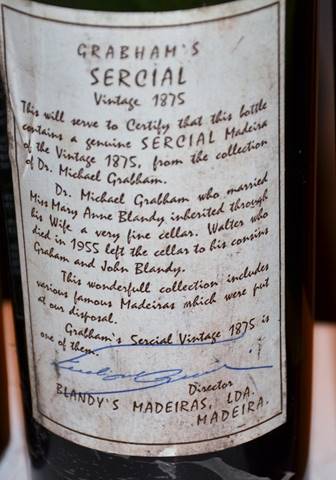
MB: 1875 Blandy’s Grabham’s Sercial
According to its back label, this wine came from the collection of Dr. Michael Grabham. A physician with varied interests, Grabham acquired his wines primarily through his marriage to Mary Anne Blandy. (He was also the great-uncle of Noel Cossart.) When Grabham died in 1935, he left his wines to his son Walter, who died in 1955. At that point, the wines passed to Graham and John Blandy, and that’s how this wine came to market--one of a number of old Grabham Madeiras that appeared under the Blandy's label in the late 1950s and 1960s. Michael Grabham is remembered for having first told (and perhaps invented) the story of the so-called 1792 "Napoleon" Madeira in 1933. But he is also remembered as the source of some of the greatest Madeiras of the 18th and 19th centuries.
RH: 1875 Blandy’s Grabham Sercial Vintage Madeira – Medium copper-amber color at the center and meniscus. Savory scents of sautéed onion, saline, mandarin orange and lemon zest are captivating. Elegant and smoky -- made for a fine first impression, then the medium weight and overt sweetness up front had me thinking Verdelho. Here too, I found a slight pang for more acidity, while enough to provide even balance, it could have been a serious contender. Nonetheless, the panoply of citrus tang and tropical fruit flavors along with a sinfully sweet, soft lingering butterscotch essence on the finish, won me over. 93 points 4/30/16
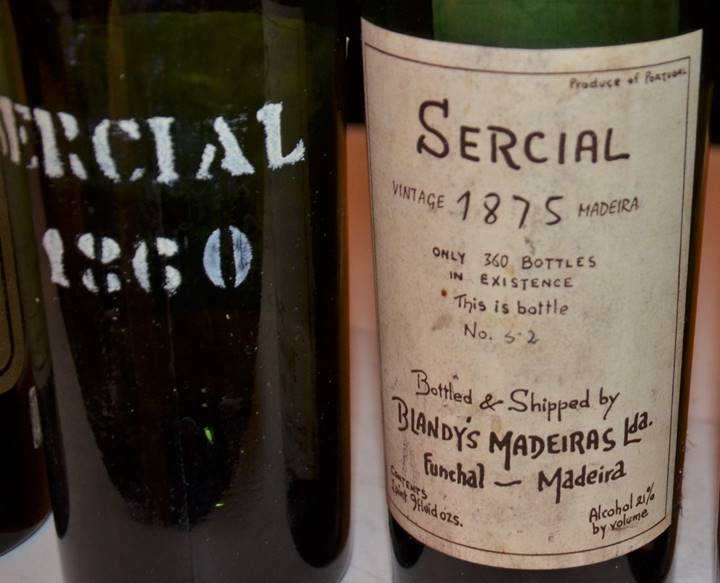
MB: 1870 Ricardo Vasconcelos Sercial "RV"
According to Ricardo Freitas, this wine belonged to the Vasconcelos family, the owners of Quinta da Piedade in Jardim do Mar. The family was important not only as winegrowers, but as distillers and as sugar cane processors (until that business ended in the 1980s). This particular wine was passed to Ricardo by his nephew, Ricardo Vasconcelos in a demijohn 5 or 6 years ago, and then bottled by Ricardo Freitas. Ricardo Freitas believes that the same wine had previously been bottled for use at his nephew’s wedding.
RH: 1870 “RV” Sercial Vintage Madeira – RV = Ricardo Vasconcelos.
Medium dark caramel color with straw gold rim. A singular but heady bouquet of chestnut, iodine and saline followed by a prominent sun-dried tomato note and blend of exotic Indian spices. Not easy to describe and although unusual, it was certainly expressive. A dollop of sweetness early on, and medium-full bodied, the flavors ranged from Sultana and dried figs to pecan and peach. A bit four square, with ample acidity, but lacking depth at its core and length during the finish. This vintage took place just before Phylloxera’s devastation of the vineyards on the island. 91 points 4/30/16
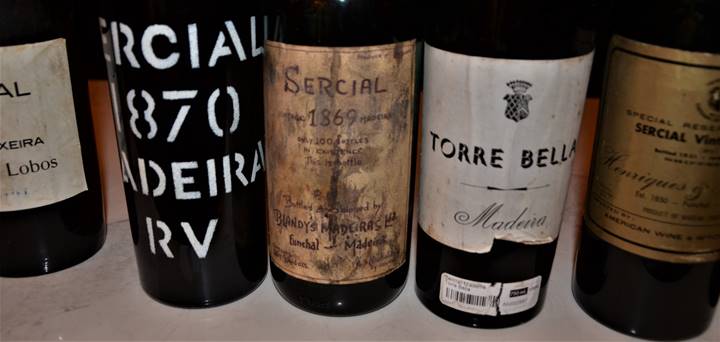
RH: 1869 Blandy's Sercial – Mannie decided not to comment on what turned out to be an obviously fraudulent bottle.
RH: 1869 Blandy’s Sercial Vintage Madeira – Slightly cloudy appearance with a light tawny-amber color and yellow edge. Aromatically reticent early on, this Blandy’s opened up slightly to reveal notes of mahogany, a significant whiff of VA, roasted nuts and lifted citrus peel. It was an extremely dry Sercial to the point of being off-putting, and I am normally a big fan of Sercial’s drier style. The varnish laden character, along with some young fruit and nut driven flavors, including Satsuma and roasted walnuts, seemed rather simple with aguardente spoiling the finish. After the flight was evaluated, a couple of extremely knowledgeable guests pointed out the likelihood that this was a “fake” and upon further inspection and discussion there had been a T-stopper type cork, typically found on inexpensive and young bottlings. The remnants of the Selo also looked to be from a modern version. It is a shame that fraudulent bottles of Madeira, (especially at auction in recent years) have become more prevalent. Previously, Madeira had very few bottles tampered with in this way. Not Rated 4/30/16
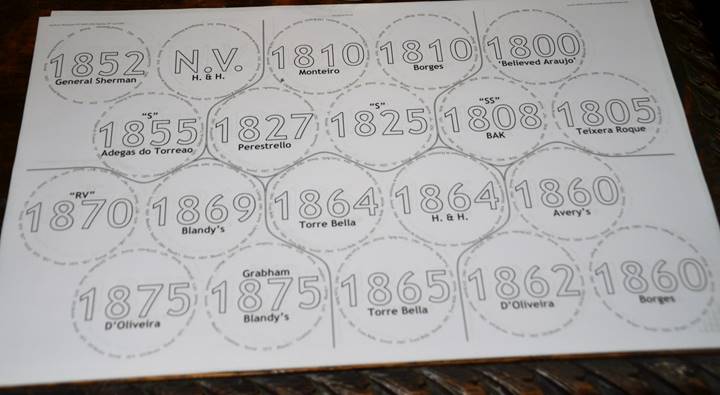
2nd Flight:
MB: 1865 Torre Bella Sercial
Bottled in a Burgundy-style bottle with a reddish-brown wax capsule, this was purchased at a Christies auction in December 2014. The catalogue stated: "This Sercial 1865 came directly from an heir of the Torre Bella family. A small number of bottles were auctioned in London last year." By the 18th and 19th centuries, the descendants of João Alfonso Correia are estimated to have owned as much as half of the island. And in 1812, they earned the right to be called Visconde de Torre Bella, a title befitting Madeira’s biggest landowners. The Torre Bella estate encompassed a great deal of the island’s prime vineyards, including sites in Câmara do Lobos, Ribeira Brava and Campanário. At one time, it even included the great Malmsey vineyards at Fajã dos Padres. But by the end of the 1980s, the family had almost died out, with just one direct descendent, Susan, the Viscondessa and Condessa de Torre Bella, surviving. In November, 1988, most of the Torre Bella Madeiras of Susan’s sister Ann (who’d died in 1986) were sold at Christies in London. Presumably, this bottle belonged to either Susan or Ann.
RH: 1865 Torre Bella Sercial Vintage Madeira – Medium dark coffee color with a gold rim. This had an awful musty and medicinal aromatic initially and this is exactly what “bottle stink” presents to me. Would it change with more time in glass? Fortunately, it did, but not enough. A disparate mix of Hoi Sin sauce, furniture polish, toffee, camphor and some residual underlying mustiness. The palate was not all that pleasant either, delivering bone-dry Sercial flavors of walnut shells and grapefruit pith, overly aggressive mouth-puckering acidity, and a noticeably angular short pecan-infused finish. Some liked it more than I did … but not by much. 76 points 4/30/16
MB: 1864 Torre Bella Câmara de Lobos Sercial
While one side of this bottle has the typical black and white Torre Bella label, the other side has a far less usual—and apparently older—label that indicates that the wine is from the heirs of Francisco E. Henriques. This bottle is Bordeaux in shape.
RH: 1864 Torre Bella Câmara de Lobos Sercial Vintage Madeira – From a Bordeaux shaped bottle. Medium dark tea optic with a light golden edge. An odd chemical scent eventually blew off as the 1864 unfurled in glass, propped by fragrant molasses, distinctive aged mahogany, maple, sweet saddle leather and pungent VA. The palate was far more enticing, with a smooth and concentrated interplay of lemon and lime zest, tantalizing tangerine, and sweet toffee that followed the swallow. The sharpness of the acidity in this Sercial challenged me to the threshold of my tolerance; (but it was still better balanced than the prior Torre Bella ‘65) leading to a medium length prickly finish. At one time, Torre Bella was the largest land owner of vineyards on the entire island. 89 points 4/30/16
MB: 1864 Henriques & Henriques Sercial
The back label of this bottle reads: "This will serve to Certify that this bottle contains a genuine very old Sercial Madeira which, when inherited by Mr. João Joaquim Henriques, Managing Director of this firm, from his father who died in 1895, was known to be a wine of the 1864 vintage. This wine was kept and aged in oak casks until bottled in 1931 and was rebottled in 1961. Only 208 bottles remain in existence.” Originally ported into the United States by American Wine & Importing Co. of Dallas.
RH: 1864 Henriques & Henriques Sercial Vintage Madeira – Having tasted a wide swath of 1862 and 1863 Madeiras, it was my first time evaluating consecutive 1864s. Medium dark cola color with a broad medium-gold rim. After a couple of disappointing bottles, it was nice to be back on track, with this Sercial offering an elaborate array of citrus fruit-driven aromas, without distraction. An ethereal mélange of blood-orange, lime, marzipan, pipe tobacco, toasted coconut and baking spices captivated my nose in glass. It was immediately apparent that this was a harmonious wine with all flavor and structural components in synch. The acidity was penetrating, yet focused and melded well with the bittersweet taste and delicate texture of the H&H. This Sercial atypically seemed to be more illustrative of the sweet outer edge of the Verdelho grape and not far from the Boal range. The palate provided a sweet punch of rum raisin, zesty lime and nutty Amaretto with a rich, lingering and multifaceted finish. This 1864 spent sixty seven years in cask before being bottled in 1931, and then rebottled exactly thirty years later. 95 points 4/30/16
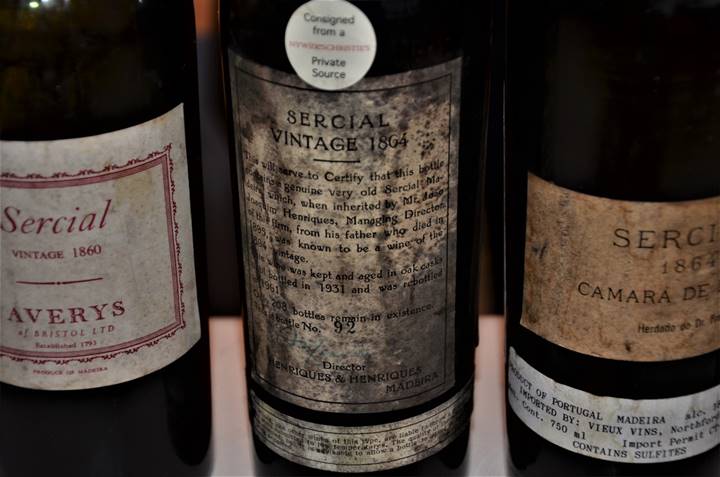
3rd Flight:
MB: 1862 D'Oliveira Sercial
Produced at the midway point between the arrivals of Oidium and Phylloxera on the island. For more on D’Oliveira, see the note above for 1875 D’Oliveira Sercial.
RH: 1862 D’Oliveiras Sercial Vintage Madeira – Medium orange-amber hue with a greenish-gold meniscus. An expansive torrefacted essence dominates and is then followed by exotic notes of peach marmalade, antique mahogany, beef bouillon, cashew and a smoky/charred characteristic. This fragrant silhouette is rather incredible for those that appreciate the sheer decadence of nosing ancient Madeira. Segue to the palate where this Sercial provides a medium weight frame, yet is mouthfilling and luxuriant until the precise moment at which the acidity cleaves like a guillotine. The beauty here is the ensuing extraordinary balance, where sharp-edged acidity meets just enough residual sugar in the candied hazelnut, pink grapefruit, burnt caramel and mandarin orange flavors – that the interplay – just works perfectly. 1862 is considered one of the great vintages for Madeira. This D’Oliveiras Sercial, which I know quite well exhibits a delicate, focused and persistent nature with an expansive aftertaste that keeps on ticking. The typicity of today’s bottle was spot on. 94 points 4/30/16
MB: 1860 H. M. Borges Sercial
Purchased at the Christie's New York auction on December 2, 2015. From a family collection on the island, believed to have belonged to the Araujos. The bottle itself is interesting, in that each side is fully labeled with separate rebottling dates. The stenciled side indicates the wine was rebottled in 1977. The side with the paper label indicates a 1994 rebottling. Presumably, both are true. Founder and proprietor of the H.M. Borges Madeira house, Henrique Menezes Borges was renowned for his acumen in buying old wines. Since this wine predates the firm’s founding in 1877, it is likely that it was purchased from another source by H.M.
RH: 1860 H.M. Borges Sercial Vintage Madeira – Medium copper tone with a gold-green rim. My first time trying this wine; initially there was a high-toned perfume with eucalyptus, iodine, VA and wasabi mustard note that was impossible to miss. Later on scents of praline, nectarine and tobacco leaf, but some of the earlier lifted fragrances were gone. Madeira is like that, aromatically morphing with regularity and hard to pin down even fifteen minutes later. Slightly sweet on entry, but off-dry overall, this is a very well made Sercial that is soft, intricate and velvety texturally. The ample acidity is just enough to provide solid balance. Flavors ranged from molasses to dried dates, sandalwood, toasted almond and later on, a hint of pecan pie. Sophisticated layers persist in the mid-range, yet more electricity in the acid would have improved the precision and elongated the medium-long aftertaste, to become a show stopper. This H. M. Borges rebottled in 1994, was much to my liking! 93 points 4/30/16
MB: 1860 Avery’s Sercial
In the 1950s and 1960s, the Bristol, England, wine merchant, Avery's, was perhaps the richest source of very old and great Madeira in the world. Most of Ronald Avery’s wines are believed to have come from either the Madeira Wine Association or the estate of the late Stephen Gaselee. But with little old Madeira left to buy, Avery wound down his Madeira business in the late 1960s. With respect to this bottle of 1860 Sercial, Paul Day writes that “this bottling by the Bristol wine merchant Avery’s was sourced from the Madeira Wine Company. The year 1860 provided the basis for the best known Sercial Solera from the MWC, and was bottled at different times under various labels, the Cossart-Gordon Solera being the most frequently encountered. There was a much more limited amount of vintage Sercial from this vintage, although it has surfaced under several MWC names. Avery’s mostly bottled Vintage wine sourced from the MWC (1826 Bual Solera and 1822 Verdelho Solera being exceptions) and there is no reason to think this wine might a Solera masquerading as a Vintage. The wine is very likely to be the same as the Cossart-Gordon Vintage 1860, perhaps bottled at a different time.” This bottle had a Christie’s London neck tag that indicates it had been sold on September 21, 1978, as lot 309.
RH: 1860 Avery’s Sercial Vintage Madeira – Medium tea color with a tawny edge. Fine aromatic accents highlighted by tropical and nutty notes of ripe apricot and nectarine, almond paste, along with savory beef bouillon, ocean breeze and key lime. The Avery’s Sercial is quite dry, with seamless citric acidity and a silky refined mouthfeel interspersed with torched sugar, delicate Frangelico, off-dry blood orange and luscious marmalade flavors. Light and vinous, this flows easily and is rather approachable from the very first sip. Gentle and simple, its strong suit is definitely the flavor profile and the excellent length of the lemony finish. 92 points 4/30/16
4th Flight:
MB: 1855 Adegas do Torreão "S"
Adegas Torreão, an important partidista located near the historic Hinton Torreão sugar works in Funchal, was founded in 1949 by Vasco Loja, who—during the difficult years of the 1960s and 1970s—built Torreão into one of the island’s most powerful wine companies, supplying large amounts of wine to the island’s remaining shippers. On Loja’s death, D’Oliveira purchased the company’s lodge building and whatever wine was remaining in barrel. This particular bottle, with its embossed lead capsule, was clearly bottled many years ago and possibly very near to the firm’s founding.
RH: 1855 Adegas do Torreão “S” Sercial Vintage Madeira – Amber-gold color with a straw golden rim. Had I not known what was in my glass, I might have guessed Tokaji Aszu, based on the fragrant dimensions that emerged. Distinctive botrytis cinerea dominated early on, followed by floral aromas with cinnamon, honey, ripe peach and fresh apricot notes. Significantly sweeter than a typical Sercial, I believe this had less to do with the actual level of residual sugar and more to do with the low level of acidity, preventing the sweetness from being held in check.
Not quite to the realm of Boal, but definitely pushing the far side of Verdelho. Singular flavors of honeycomb, dried plum and baked apples smothered in cinnamon, caramel and hazelnuts. Unctuous and bordering on a sugary simple syrup impression; while I liked the aromas and flavors, it provided no real sense of being Madeira, lacking the requisite structure and typicity of the Sercial grape and the rather short finish didn’t help its case. 84 points 4/30/16
MB: 1852 Sercial Selected by General Sherman on his visit at Madeira, 1871
Roy writes: “I bought this from a family on Long Island where it had sat for 3 decades, after the father had been gifted a few bottles by a wealthy wine collector whom he had done a favor for. The bottle was wrapped in its original brown paper and with the label still intact which showed the vintage as 1852 and also read: ‘Selected by General Sherman.’ It had clearly been recorked at some point in its journey. There were three bottles in all and two were labeled as Sercial .... Most likely the production of Blandy's and it apparently saw minimal time in cask. Coincidentally, this was from the same year as the Oidium outbreak on the island." MB: Sherman sailed on The Wabash from Boston on November 11, 1871, first stopping at Madeira on his way to Europe. According to a letter to his son, at the request of a US Navy Admiral, Sherman visited a Mr. Walsh while on the island. It seems of interest that, while the letter describes much about the visit, Sherman says nothing about wine. Is it possible that Mr. Walsh was Mr. Welsh, of Welsh Bros. (who were of American descent), suggesting that firm as another possible source for the wine.
RH: 1852 General Sherman Sercial Vintage Madeira – “Selected by General Sherman on his visit to Madeira, 1871” was written on the label of the bottle. Unearthed in the basement of total strangers that had contacted me and were looking to sell these, from their home on Long Island, (NY). Three decades hence, they had been gifted to the father of this family for some construction projects where he had been the general contractor for works on their home. The current owner wanted to ensure they would be sold to a worthy owner; and they were stored in a wooden cabinet, opposite their washer and dryer ever since they had been received, and supposedly had never moved. They were wrapped in 19th century old and fragile paper with labels on these outer papers as well as on the bottles. There was no question that these were very old, but without capsules, I was able to see rather new corks. Pale golden-amber in color and a thin yellow rim. When I decanted this bottle, it initially had significant bottle stink and like its siblings, I hoped it would blow off during the week it rested prior to our tasting. The aromatics were light and offered spicy notes, with cinnamon at the fore, also subtly scented pear, almond, leather and golden raisins. Delicate and with an oily texture, (similar to that of well-aged Meursault) it gained modest richness in the glass with well-tamed acidity. It likely spent a few decades in wood and lots of time in demijohn. The flavors were austere and dry initially, with grapefruit and leather along with genteel volatile acidity; but sweeter characteristics also prevailed: honey cake, crème brûlée and Dutch toffee candies. The mid-section lacked depth and lead to an aftertaste that disappeared shortly after swallowing. The story surrounding this wine was the best part of the journey. Previous bottles showed better. 83 points 4/30/16
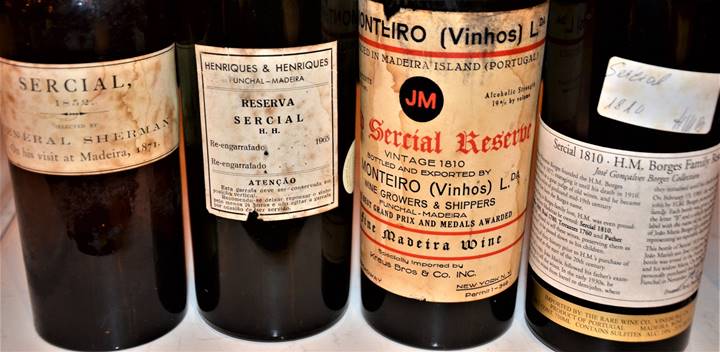
MB: Henriques & Henriques Reserva “H.H.” Sercial
Acquired at a Christie's New York auction on December 2, 2015. From a family collection on the island. Related to the Henriques & Henriques Heavenly Quartet celebrated by Alex Liddell in his book, Madeira. Though not mentioned by Liddell, it is one of the very old undated Madeiras that survived in the H & H inventory until at least the end of the 20th century. Like the others, it may date from the early 1800s and should therefore be pre-Phylloxera. By reputation, these wines belonged to the company when it was founded in 1850.
RH: NV Henriques & Henriques Reserva “H. H.” Sercial Vintage Madeira – Darkest of the flight and one of the darkest of the tasting, presenting a nearly opaque coffee appearance with a greenish tinged meniscus. Swirling scents of maple syrup, wood-burning fireplace, toasted almonds, sugar cane and brioche were dazzling in their intricacy. The palate lent itself closer to Verdelho than Sercial stylistically, and exhibited distinctive harmony and balance throughout. In possession of a soft silky texture and near-perfect acidity with well-delineated flavors of mahogany, saline, chestnut, caramel and prune, delicious together and with layers of complexity. A mellifluous Madeira that’s à point today and with enough stuffing to last several more decades. Believed to be circa 1825-1827. 94+ points 4/30/16
5th Flight:
MB: 1827 Perestrello Sercial
Purchased from a member of the Teixeira/Araujo family. Bartolomeu Perestrello was a Genoese Navigator who landed on Porto Santo with Zarco in 1418. Although Zarco left the island, Peresstrello remained to occupy the island, eventually becoming governor of Porto Santo. The Perestrellos eventually became a very important family in Madeira and were involved in many businesses, including wine. This particular wine is probably a mid-20th century bottling.
RH: 1827 Perestrello Sercial Vintage Madeira – Medium maple-amber optic with a dark golden rim. Fragrant and ethereal whiffs of ocean mist, minerality, VA, Granny Smith apples and toffee meld well, and the aromatics are a significant strength. Poised and graceful, soft and seductive in the mouth, the acidity is mellow and citrus-based, whereas I’d prefer greater tensity here. The Sercial typicity is spot on with a fine juxtaposition between the dryness and scoach of salted lime bitter-sweetness; but the shortcoming is the actual length, which clumsily falls off a cliff way too quickly. The 1827 is a fine sipper with a stunning nose at nearly 190 years old. 90 points 4/30/16
MB: 1825 "S" Sercial
From its appearance, this bottle has all the earmarks of the Braheem Kassab 1825 “S.” However, it lacked a BAK capsule. Bob Stern writes: “The 1825 may or may not be ex-Kassab. It is absolutely the same as the Kassabs, but my suspicion is that this was purchased at the same time (or even before) Kassab. In the collection there were also two bottles of the 1830 that is known from Kassab in the identical early 1800 dip mold bottle. I believe these came from the Araujo family ... the last of the dispersal from this particular family's ancient collection.” According to Bob, the same collection yielded a 1715 'Terratez' (sic), with the identical stencil and misspelling, but without the Kassab seal—which other bottles of 1715 Terratez have had—or the JCA & Co shipper stencil, which the same bottles have had. Therefore, Bob thinks they may have come from the same original source as the Kassab bottles. (See note below on the 1808 BAK Sercial.)
RH: 1825 “S” Sercial Vintage Madeira – Dark brown color resembling molasses and fully opaque with a greenish tinged meniscus. There was something off-putting about this Madeira before it was even sipped. The aromatic profile didn’t seem to fit a Sercial whatsoever; the nose offered up stewed cinnamon apple notes, menthol, apple cider, mace and nutmeg spice, and a vitamin pill (One-A-Day) note. The palate provided similar flavors along with dried plum and Sultana. This viscous odd duck exhibited very little acidity and the finish lasted for only a few seconds. I couldn’t figure out what was wrong with this wine, but there was nothing that represented Sercial style. Due to the lack of a BAK embossed capsule, several experts in the room believed this to be the second fraudulent bottle at the tasting. The jury is out. Not Rated 4/30/16
MB: 1810 Monteiro Old Sercial Reserve
Bottle no. 112 imported by Kraus Bros NYC, probably in the 1950s. Though now forgotten, Monteiro was an important shipper on the island in the early 1800s. Monteiro's Meteor, Monteiro's Old Brazil, Monteiro's Reserve, Monteiro's Nord Polen, and Monteiro's London Particular appeared prominently on hotel wine lists in the United States prior to the Civil War.
RH: 1810 Monterio Old Reserve Sercial Vintage Madeira – Medium copper-orange hue with a broad golden edge. The ever changing bouquet was the best part of this wine, yet not without some notes that were out of sorts: vanilla, herbs, char, maple bar, pine, beef bouillon and a mix of medicinal scents and a strong lactic aroma. My initial impression of the flavor profile was “weird”, partially due to the malic acid’s sour notes, but more so, the distinct prune and dried fig flavors, way too sweet for Sercial, and lastly the very short finish. It was certainly quaffable and some people seemed to like this way more than a bunch of us “naysayers” … but for me, it lacked any real sense of distinguishable typicity. To its credit, some of the off-putting aromatics did blow off later in the tasting. 84 points 4/30/16
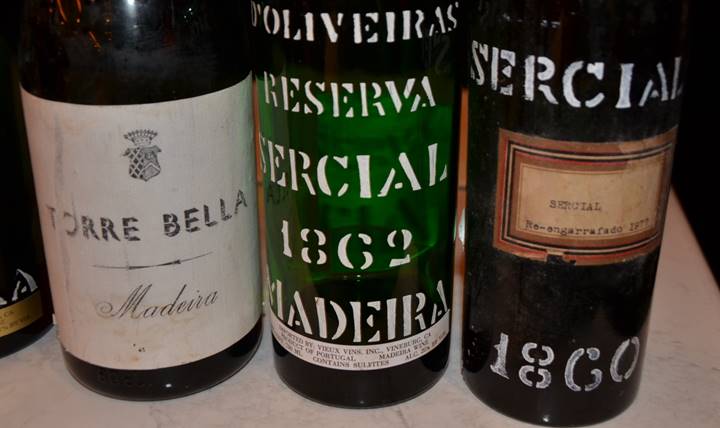
MB: 1810 H. M. Borges Sercial
From the collection of José Gonçalves Borges. Purchased from RWC in June 2012. Of the old wines that H.M. Borges purchased during his life, he prized five in particular: an 1810 Sercial, 1800 Verdelho, 1780 Boal, 1760 Terrantez and 1720 Pather. And when he died in 1916, he passed these on to his three children. The wines eventually went to one son, João Maria, who on his death in 1989, bequeathed them to his six children. Each offspring received an equitable distribution of the five wines—each labeling their bottles in their own way. On February 13, 1989, this bottle of 1810 Sercial was bottled from demijohn by H.M. Borges personnel in the presence of the Borges family. Of the 14 demijohns bottled that day, two were of 1810 Sercial, producing 45 bottles, shared among 5 children and a half sister. The wines had all been purchased by H.M. Borges at the end of the 19th or beginning of the 20th century, either in demijohn or in cask. They were all believed to have been vinhos do roda (when young, the wines had sailed to the Indies and back for conditioning).
RH: 1810 H. M. Borges Sercial Vintage Madeira – Medium amber-orange color with a broad greenish-gold rim, this was the lightest and most translucent wine in the flight. The H. M. Borges had a really unique profile and called for a pair of descriptors that I can’t remember ever using for Madeira: distinctive brazil nut and allspice aromas, joined by a sweet note of crème brûlée and by other baking spices, lime zest and mandarin orange. Sheer pungent intensity of aromas and a singular Sercial silhouette standing above all competitors in this entire lineup. Some guests were not as intrigued, but in this case, the vast majority agreed. A light and lithe mouthfeel until the razor sharp acidity cut to the heart of this wine’s dry essence and bolstered the flavors of tangerine, dried dates, grapefruit and Key lime, a fine union of citrus and tropical fruits. An infusion of singed caramel and Amaretto on the lingering if not profound finish was the final piece of this sophisticated Sercial puzzle. 96 points 4/30/16
6th Flight:
MB: 1808 Braheem Kassab (BAK) "SS" Sercial
The collection of Braheem Kassab is legendary; in fact, no initials embossed in a Madeira capsule are more desirable than those of BAK. But surprisingly little has been written about him. Fortunately, I had the chance to interview his son, Eddie, a few years ago. According to Eddie, his father was in the linen and embroidery trade on the island. He was born circa 1891 in Damascus, Syria, and died in 1980, aged 89. He arrived in Madeira in 1916 from New York. According to Eddie, he didn’t drink Madeira, preferring, as many Madeirans do, Scotch. He acquired his Madeira collection by loaning $4000 to Reids & Castro Bank when it was on the verge of collapse during the Great Depression. According to Eddie, he knew the bank was doomed, but he was happy to take Reids Hotel’s wine collection as collateral. The collection remained intact until Braheem’s death, when it was dispersed.
RH: 1808 Braheem Kassab “SS” Sercial Vintage Madeira – The BAK capsule story raised expectations for our participants. Light-to-medium caramel color with a straw-yellow meniscus. The BAK nose rivals that of the off-the-charts 1810 Borges in its ethereal if not hedonistic nature. Loaded with swirling scents of mahogany, honey, fresh cinnamon stick, figs and baking spices. What can I say beyond, my nose was immersed in the glass for minutes at a time? Racy, tart and edgy, a scintillating Sercial, with tangy electric acidity, otherwise a soft and velvety impression tantalizes the tongue. Piquant flavors of Medjool dates and apricots, walnuts, sea salt and charred wood. Excellent structurally, deftly balanced and great purity of Sercial style with a mouthwatering, persistent finish. 95 points 4/30/16
MB: 1805 Teixeira Sercial “Roque”
Paul Day, (one of our guests) believes that this bottle originated from a member of the Welsh family, one of the few families still involved with wine on the island in the 20th century who had emigrated from America. This bottle was one of two auctioned by Christies in December 2013 in London. (Rebottled 1949 and more recently recorked.) Two further bottles were auctioned by Christies in New York a year later. According to Paul, “The Teixeira family are descendants of one of the first to discover the island of Madeira in 1418, Tristão Vaz Teixeira. Henrique Teixeira is a living descendant of Tristão Vaz Teixeira and is the great-grandson of Roque Teixeira. It has been suggested that other old Sercials described in Alex Liddell's book may have some connection with this wine (i.e., the 1789 RT and the 1795 JRT) although this is very difficult to ascertain. Teixeira is a relatively common name in Madeira and in a sense all families with the Teixeira name in Madeira, unless they or their ancestors arrived on the island later, are descended from Tristão Vaz Teixeira, so they are all at least remotely related. Anyway, irrespective of the relationship to other wines, this wine itself has a good reputation, described in a blind tasting on the Island as ‘one of the best old Sercials.’”
RH: 1805 Teixeira “Roque” Sercial Vintage Madeira – A crowd pleaser and one of the favorites of the participants at the NY tasting. Medium-dark maple color with a golden-green edge. The nose immediately rivets attention with robust fragrances of saddle leather, sandalwood, clove and cinnamon, tincture of iodine, old mahogany and a sweet note of salted caramel. Medium weight and as it opened, this 211 year old Madeira is well-preserved and presented a sensual mouthfeel that was sleek, polished and creamy … impressive, given its age. The mid-section was labyrinthine with waves of diverse flavors and a dichotomy of both dry vs. sweet, including sea salt, grapefruit peel, toffee, blood orange and a charred espresso bean quality. The highlights were the exemplary balance due to the penetrating precision of the acidity, the character and typicity of Sercial in this Teixeira, and the superlative length of the finish. 94 points 4/30/16
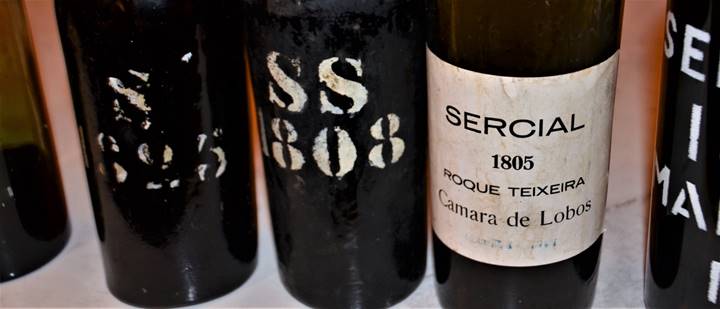
MB: 1800 (believed Araujo) Sercial
This was purchased as lot 554 at Christies New York, on March 27, 2015, as “believed Araujo Family, per collector's cellar records." The Araujos are one of Madeira's oldest families, having come (according to Richard Mayson's book) "from Mainland Portugal at the end of the fifteenth century ... They own vineyards at Jardim da Serra and Estreito de Câmara de Lobos, and produce very fine Sercial and Verdelho. The family continues to farm at Quinta do Jardim da Serra, having once owned Consul Veitch's old country residence. The family has a shareholding in H. M. Borges and are related to Manuela de Freitas at Barbeito. The Araujos also hold stocks of old wine." In the past, there was also an important wine partnership, Araujo Henriques, formed by Manuel Alves d’Araujo, who, according to family legend, acquired Veitch's famous estate in a card game."
RH: 1800 Believed to be Araujo Sercial Vintage Madeira – Dark amber with red glints in the core and golden rim. An interesting aromatic profile for a Sercial with well over two centuries of age, with a blend of creosote, marzipan, peat, sautéed onion, orange peel and praline. I preferred the nose to the palate, but there were compelling components there as well. Dry and piercing acidity, with an initial smoky essence, roasted hazelnuts, saline, stewed peaches, and a hint of lime on the medium length aftertaste. The fruit seems to be hanging on, likely not for long; but we caught this at the right moment in time and there was enough freshness and symmetry to keep this 1800 interesting. A great way to end our tasting with five consecutive wines with over two centuries of age. 90 points 4/30/16
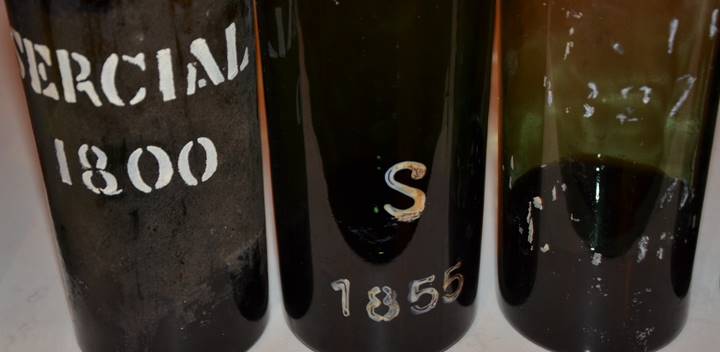
Epilogue
Sensational Sercial was the fifth in a series of six annual Madeira parties, exploring the extraordinary bandwidth of all the major grapes of the island. In 2017, we will include two grapes for the first time, in what will be our last event using the current theme based on grape variety. Our mission in this series is to locate the greatest remaining ancient bottles from each Madeira grape, and share the 20 best bottles we can find anywhere in the world, including those within the confines of our participants’ cellars.
In all of our past sessions, we have been able to achieve excellent results and include an awe inspiring array of ancient and rare bottlings. In a couple of instances, we have even been able to present a last known bottle of historically important Madeira, left on earth. With Sercial in particular, we knew there was a greater inherent potential to experience bottles that would not live up to expectations. With bottles ranging from 140 years old to two more than two centuries of age, stuff happens. While there were many strong contenders, we did not expect to encounter a pair of what turned out to be fraudulent bottles.
There were also a couple of Sercials that just did not live up to their reputations. Whether this was due to severe sharpness of the acidity, (strong acidity is a hallmark of Sercial) or the extreme dryness this grape is known for, or simply the luck of the draw with variation from such bottles of antiquity, I cannot say.
My favorite handful of Sercial’s from our tasting:
· 1810 H.M. Borges = 96 points
· 1864 H & H = 95 points
· 1808 BAK = 95 points
· 1805 Teixeira “Roque” = 94 points
· 1862 D’Oliveiras = 94 points
We were fortunate to be able to have four pairings of vintages: 1875, 1864, 1860 and 1810. It is always interesting to be able to compare and contrast two unique Madeiras from the same year and grape, and with Sercial this was certainly the case. Speaking of comparisons, last year’s Malvasia tasting had an average age of 160 years per bottle and 3200 years of combined age; with Sercial we exceeded that total by 234 years, which provided an average age per bottle of nearly 172 years old … or looking at a vintage date of 1844 as an average bottle. That just seems hard to wrap one’s brain around.
Wine historian James Aaron Nix has found a passion for Madeira in the past few years and has written some brilliant work on the subject. Here is a link to his outstanding article from his site: Hogshead – A Wine Blog. It focuses on Sercial and its popularity amongst some of our founding fathers at the beginning of the 19th century. It is well worth a read: https://hogsheadwine.wordpress.com/2016/12/21/very-scarce-sercial-in-america-at-the-turn-of-the-19th-century/
Overall, we had the opportunity to learn about the full range of Sercial’s aromatic and flavor spectrums. Moreover, we did have several exceptional bottles that demonstrated exactly how exciting Sercial can be when it has aged for well over a century and even beyond two hundred years of age. Thanks to all of the participants for sharing their knowledge and extraordinary generosity of spirit!
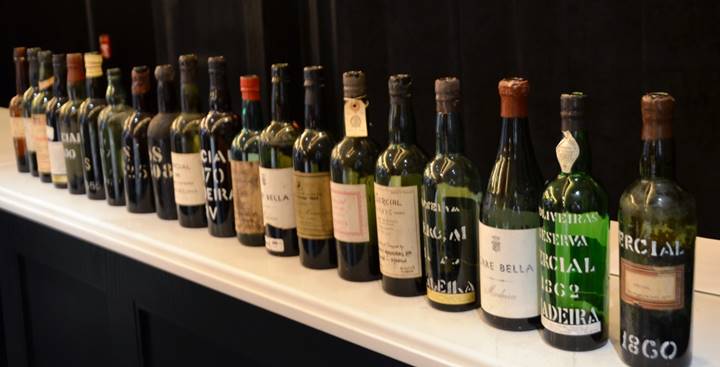
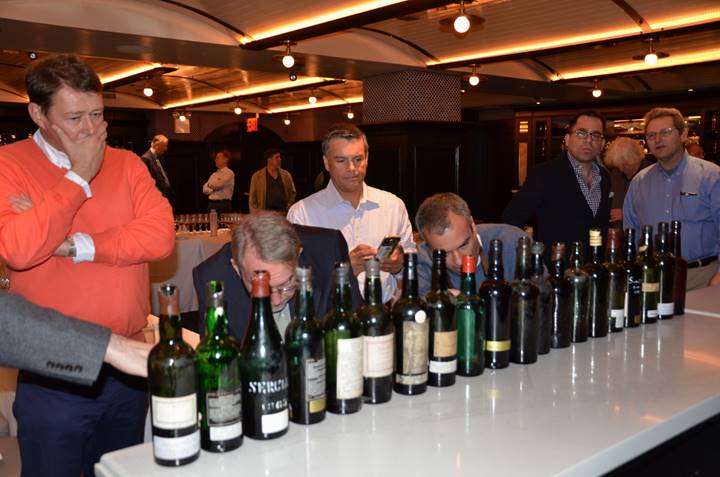
Sercial © by Richard Mayson
Roy’s note: Richard Mayson has generously allowed FTLOP to include his write up on the details and study of each grape that we have focused on, for the past four years during the NYC series of Madeira tastings. His brief on Sercial is well worth reading, as is his recent book on Madeira, mentioned below.
‘Let us begin with Sercial which, in my view, is the most exquisite of all grapes not least because of its expense and rarity and because it takes so long to meet perfection. The grapes seldom reach a perfect ripeness, always maintain a slight tartness and, being grown on the coast are scorched by the sea air and southern sun. No less than ten years are needed for this liquid to acquire the flavour, aroma and hint of burnt toffee which characterises it’.
Paulo Perestrelo da Câmara’s note written in in 1841 (Breve Noticia Sobre a Madeira) is still largely applicable today. Known on the Portuguese mainland as Esgana Cão (’dog strangler’), Sercial is characterized by ferociously high levels of natural acidity. Perhaps for this reason it was often said to be related to Rhine Riesling but there is in fact no connection at all.
Sercial probably originates from the Lisbon region where in Bucelas, growing alongside the slightly less acidic Arinto, it produces crisp, dry white wines. In the late nineteenth century this wine was marketed as ‘Portuguese Hock’, perhaps perpetuating Sercial’s mythical relationship with Riesling. Growing so close to the port of Lisbon, it is logical that Sercial was one of the first grapes to be planted on Madeira after the island was colonized in the fifteenth century.
Very occasionally it is referred to on Madeira as Esgana, ‘Esganinho, Esganiso or Esganacão. The word esgana means ‘strangle’ or ‘choke’ in Portuguese, a reference to the high natural acidity that this grape retains almost wherever it is grown, even in relatively warm conditions. Sercial on Madeira is sometimes confused with Cerceal or Sercialinho, which grow in the Dão and Bairrada regions respectively, but these are different varieties.
In his book Facts about Port and Madeira published in 1880, Henry Vizetelly describes Sercial as ‘now exceedingly rare’ and describes the wine as ‘strong, dry…possessing an exquisite bouquet’. He goes on to observe with accuracy that ‘when young, however, this wine is harsh to the palate, age being requisite to bring it to perfection and develop that nutty flavour for which it is distinguished.’ Sercial is still very rare with just 17.8 ha vineyard on the island. In Vizetelly’s time, it was to be found growing at Ponta do Pargo on the southwest tip of the island.
Nowadays, Sercial is mostly to be found growing at the highest altitudes on the south side of the island with 8.6 ha planted at Jardim da Serra up to 800m above Câmara de Lobos. Sercial is also planted close to sea level around Porto Moniz / Seixal (6.4 ha) on the cooler north coast. At high altitudes Sercial is usually trained close to the ground to gain the maximum amount of heat from the volcanic soil. There is also some Sercial planted at my brother-in-law’s property, Quinta de Santa Luzia approximately 145 metres above sea level in Funchal, where bud burst is very variable. On some canes a few buds would burst in spring whilst others remained latent, only to burst later in the year.
Resistant to oidium, Sercial is generally the last grape to be harvested, ripening with some difficulty to a maximum of 11º Baumé. The grapes form large bunches but are thin skinned and prone to rot. Apart from Terrantez, Sercial is the least productive of the traditional white grape varieties. It is not therefore popular with growers. But Sercial produces some of the most enduring Madeira wine, kept alive for decades by searing levels of acidity (up to 12g/l in some wines).
Some wines are ethereal, the racy acidity offset and beautifully balanced by a few grams of residual sugar. It is my impression that recently bottled colheitas and frasqueiras (vintage wines) tend to be sweeter in style. Under the legislation introduced last year, a so called ‘dry’ wine (which equates with the definition of Sercial) may be bottled with up to 1.5 Baumé of residual sugar.
But I have certainly come across some old, very dry Sercial wines with what I refer to as ‘head-banging’ levels of acidity that are not particularly pleasant to drink. Perhaps because of its dryness and austerity, Sercial is the least appreciated style of Madeira and production continues to decline with few new vineyards having been planted in recent years. It seems that this, the most underappreciated of Madeira’s grapes, will always be a rarity.
From Richard Mayson’s book, Madeira, the Islands and their Wines, published by Infinite Ideas, Oxford, England in 2015.

Leave A Comment
You must be logged in to post a comment.